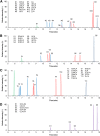Targeted profiling of circulating and hepatic bile acids in human, mouse, and rat using a UPLC-MRM-MS-validated method
- PMID: 22822028
- PMCID: PMC3435556
- DOI: 10.1194/jlr.D028803
Targeted profiling of circulating and hepatic bile acids in human, mouse, and rat using a UPLC-MRM-MS-validated method
Abstract
Bile acids (BAs) are a group of chemically related steroids recognized as regulatory molecules whose profiles can change in different physio-pathological situations. We have developed a sensitive, fast, and reproducible ultraperformance liquid chromatography/multiple reaction monitoring/mass spectrometry method to determine the tissue and sera BA profiles in different species (human, rat, and mouse) by quantifying 31 major and minor BA species in a single 21-min run. The method has been validated according to FDA guidelines, and it generally provides good results in terms of intra- and interday precision (less than 8.6% and 16.0%, respectively), accuracy (relative error measurement between -11.9% and 8.6%), and linearity (R(2) > 0.996 and dynamic ranges between two and four orders of magnitude), with limits of quantification between 2.5 and 20 nM. The new analytical approach was applied to determine BA concentrations in human, rat, and mouse serum and in liver tissue. Our comparative study confirmed and extended previous reports, showing marked interspecies differences in circulating and hepatic BA composition. The targeted analysis revealed the presence of unexpected minoritary BAs, such as tauro-alpha-Muricholic acid in human serum, thus allowing us to obtain a thorough profiling of human samples. Its great sensitivity, low sample requirements (25 µl of serum, 5 mg of tissue), and comprehensive capacity to profile a considerable number of BAs make the present method a good choice to study BA metabolism in physiological and pathological situations, particularly in toxicological studies.
Figures


Similar articles
-
Ultra-performance liquid chromatography-mass spectrometry targeted profiling of bile acids: application to serum, liver tissue, and cultured cells of different species.Methods Mol Biol. 2014;1198:233-47. doi: 10.1007/978-1-4939-1258-2_15. Methods Mol Biol. 2014. PMID: 25270933
-
Development of analytical method for simultaneous determination of five rodent unique bile acids in rat plasma using ultra-performance liquid chromatography coupled with time-of-flight mass spectrometry.J Chromatogr B Analyt Technol Biomed Life Sci. 2015 Oct 1;1002:399-410. doi: 10.1016/j.jchromb.2015.08.047. Epub 2015 Sep 3. J Chromatogr B Analyt Technol Biomed Life Sci. 2015. PMID: 26363851
-
Bile acids metabonomic study on the CCl4- and alpha-naphthylisothiocyanate-induced animal models: quantitative analysis of 22 bile acids by ultraperformance liquid chromatography-mass spectrometry.Chem Res Toxicol. 2008 Dec;21(12):2280-8. doi: 10.1021/tx800225q. Chem Res Toxicol. 2008. PMID: 19053324
-
Robust and Comprehensive Targeted Metabolomics Method for Quantification of 50 Different Primary, Secondary, and Sulfated Bile Acids in Multiple Biological Species (Human, Monkey, Rabbit, Dog, and Rat) and Matrices (Plasma and Urine) Using Liquid Chromatography High Resolution Mass Spectrometry (LC-HRMS) Analysis.J Am Soc Mass Spectrom. 2021 Aug 4;32(8):2033-2049. doi: 10.1021/jasms.0c00435. Epub 2021 Apr 7. J Am Soc Mass Spectrom. 2021. PMID: 33826317
-
Detection technologies and metabolic profiling of bile acids: a comprehensive review.Lipids Health Dis. 2018 May 23;17(1):121. doi: 10.1186/s12944-018-0774-9. Lipids Health Dis. 2018. PMID: 29792192 Free PMC article. Review.
Cited by
-
The changes of hepatic bile acid synthesis and transport and bile acids profiles in isopsoralen-induced liver injury C57BL/6J mice.Pharm Biol. 2022 Dec;60(1):1701-1709. doi: 10.1080/13880209.2022.2116057. Pharm Biol. 2022. PMID: 36066106 Free PMC article.
-
Feeding Corn Silage or Grass Hay as Sole Dietary Forage Sources: Overall Mechanism of Forages Regulating Health-Promoting Fatty Acid Status in Milk of Dairy Cows.Foods. 2023 Jan 9;12(2):303. doi: 10.3390/foods12020303. Foods. 2023. PMID: 36673395 Free PMC article.
-
Population pharmacokinetic model to generate mechanistic insights in bile acid homeostasis and drug-induced cholestasis.Arch Toxicol. 2022 Oct;96(10):2717-2730. doi: 10.1007/s00204-022-03345-8. Epub 2022 Jul 25. Arch Toxicol. 2022. PMID: 35876888 Free PMC article.
-
Sandwich-Cultured Hepatocytes as a Tool to Study Drug Disposition and Drug-Induced Liver Injury.J Pharm Sci. 2016 Feb;105(2):443-459. doi: 10.1016/j.xphs.2015.11.008. J Pharm Sci. 2016. PMID: 26869411 Free PMC article. Review.
-
Bile acid-microbiota crosstalk in gastrointestinal inflammation and carcinogenesis.Nat Rev Gastroenterol Hepatol. 2018 Feb;15(2):111-128. doi: 10.1038/nrgastro.2017.119. Epub 2017 Oct 11. Nat Rev Gastroenterol Hepatol. 2018. PMID: 29018272 Free PMC article. Review.
References
-
- Botham K. M., Boyd G. S. 1983. The metabolism of chenodeoxycholic acid to beta-muricholic acid in rat liver. Eur. J. Biochem. 134: 191–196 - PubMed
Publication types
MeSH terms
Substances
LinkOut - more resources
Full Text Sources
Other Literature Sources

